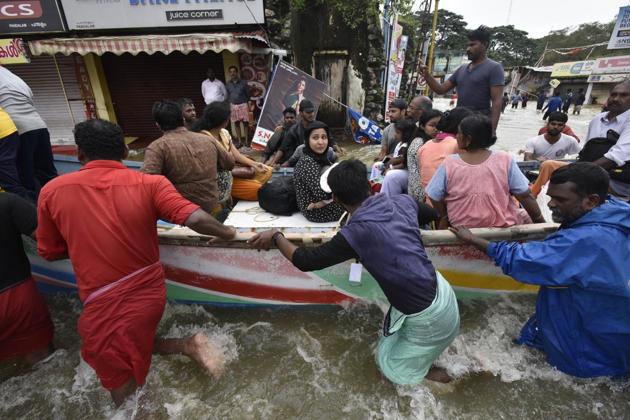Kerala flood: Some lessons to learn
Keralites have earned new admirers for the manner in which they faced the flood fury.
It was the highest rainfall and worst flood in nearly a century in Kerala. Two weeks after the battering, the tiny state finds itself on the long and hard road to recovery. Keralites have earned new admirers for the manner in which they faced the flood fury.

Its approach to the crisis, execution of plans, participation of social groups or local expertise in rescue and relief operations, and roles played by political leaders are lessons on flood (or crisis) management which, at some stage, ought to be studied and codified. As a densely-populated, commercially-significant and sea-bordering city which lived through a similar devastating flood in July 2005, Mumbai would do well to learn them.
The task was/is daunting: more than 370 people dead, over one million housed in 3,270 relief camps, more than 20,000 houses washed away, nearly 10,000kms of roads damaged, the total loss running into R20,000 crore. A hitherto much-vilified chief minister Pinarayi Vijayan turned into an unlikely role model. That the union government parted with a tiny fraction of his demand for relief package, that right-wing trolls mocked the flood as retribution for Kerala’s beef-eating practices and its government’s support for women’s entry into Sabarimala temple added to his stature.
The debate over the cause of the flood is raging. Did natural causes lead to the flood or was the unusually high rainfall exacerbated by development policies? The Madhav Gadgil-authored Western Ghats Ecology Expert Panel report had pointed out the need to protect the state’s ecology. Gadgil has now warned that parts of Maharashtra and Goa could see similar devastation. Unusual or extreme rain events, flash floods and landslides are more possible than thought earlier.
The first learning from Kerala is that it is possible to de-politicise rescue and relief operations. Political parties accept in principle that a huge natural calamity should not be politically exploited but do not hesitate to blame the government of the day, slam its shortcomings on prime time television, and play blame-games. Kerala’s politicians showed that it is possible – and recommended – to join forces across party divides in the hour of need. During the crises days, opposition leader Ramesh Chennithala was shoulder to shoulder with Vijayan.
The second learning is that it is important that top officials should be seen on the ground. From cabinet ministers to opposition leaders and bureaucrats, they were all braving the knee-high flood waters and aiding the rescue operation. It sent out a powerful reassuring message to those stranded; importantly, it signalled serious intent to the state’s machinery. This was very different from top most officers of Maharashtra or Mumbai sitting in “war rooms” to “monitor” the situation.
The third learning is that social or civic capital of a state or city must be drafted into government/official efforts. Local people know the lay of the land, have networks beyond those of the government, can prove to be differentiating factor between disorganised and competent rescue operations. Temples, mosques, churches all turned into relief shelters. The fisher folk of Kerala, who negotiate water better than others, turned into unlikely rescuers – now generously lauded.
The fourth learning is that accurate, credible and regular information makes a critical difference between panic and relative calm. Irrespective of the content on the social media, CM Vijayan held a televised news conference every day during the worst days. He spoke directly to people, apprised them of the latest situation, redirected resources, kept lines of communication open in his office 24x7 to receive distress calls which were passed on to the National Disaster Response Force teams, the Army and other defence personnel involved in the operation.
The fifth learning is about the media. The local media, from what one knows, were unlike the hyper-ventilating channels usually seen. Many eschewed regular ad breaks – therefore, revenue – to focus on the flood coverage, changed their formats, became collection points for calls from people stranded in flood water but instead of putting it all on air passed on the information to the CM’s office. Anchors did not swim in the flood water only for cameras.
Valuable lessons, indeed, for Mumbai to take note.

Stay updated with all the Breaking News and Latest News from Mumbai. Click here for comprehensive coverage of top Cities including Bengaluru, Delhi, Hyderabad, and more across India along with Stay informed on the latest happenings in World News.
Stay updated with all the Breaking News and Latest News from Mumbai. Click here for comprehensive coverage of top Cities including Bengaluru, Delhi, Hyderabad, and more across India along with Stay informed on the latest happenings in World News.





